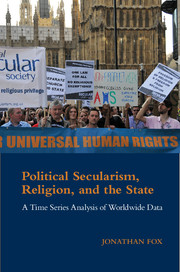Book contents
- Frontmatter
- Contents
- Acknowledgments
- 1 Introduction
- 2 Secularism or Secularization? The Secular-Religious Competition Perspective and Beyond
- 3 Establishment, Support, Neutrality, or Hostility: The Varieties of Official Religion Policy
- 4 State Support for Religion
- 5 Regulation, Restriction, and Control of the Majority Religion or All Religions
- 6 Religious Discrimination
- 7 Education, Abortion, and Proselytizing
- 8 Religion in Constitutions
- 9 Conclusions
- Appendix Data Collection and Reliability
- Bibliography
- Index
Appendix - Data Collection and Reliability
Published online by Cambridge University Press: 05 May 2015
- Frontmatter
- Contents
- Acknowledgments
- 1 Introduction
- 2 Secularism or Secularization? The Secular-Religious Competition Perspective and Beyond
- 3 Establishment, Support, Neutrality, or Hostility: The Varieties of Official Religion Policy
- 4 State Support for Religion
- 5 Regulation, Restriction, and Control of the Majority Religion or All Religions
- 6 Religious Discrimination
- 7 Education, Abortion, and Proselytizing
- 8 Religion in Constitutions
- 9 Conclusions
- Appendix Data Collection and Reliability
- Bibliography
- Index
Summary
This appendix discusses the methodology for the construction of the three central variables in this study – religious support, discrimination, and regulation. It then evaluates their validity. The content of these variables is discussed in detail in Chapters 4, 5, and 6.
Data Collection Procedures
All 175 countries that were included in Round 1 of the Religion and State Project (RAS1) are included in Round 2 (RAS2). Timor and Montenegro were added because they had recently gained independence, so 177 countries were included in RAS2.
In RAS2, as was the case in RAS1, each country was assigned to a research assistant (RA), who wrote a report based on the country. These reports cover 2003–2008 and are meant to supplement and update the RAS1 reports, which cover 1990–2002. These reports used the following sources:
• Primary sources such as constitutions and the texts of legislation and government policy papers regarding religion. In cases in which laws were not available in a language that the RA understood, Google Translate was used. A sampling of constitutions and laws that were available both in translation and in the original language were tested to see whether the Google Translate results matched the human translation. Although the texts were rarely identical, the Google Translate texts did not result in any inaccuracies that would have influenced the codings.
• News articles, mostly from a search of the Lexis-Nexis database but also obtained from other sources.
• Academic resources such as journal articles and books.
• Government and intergovernmental organization reports such as the US State Department International Religious Freedom (IRF) reports and the United Nations Abortion Policies reports, among others.
• Reports by nongovernmental advocacy groups and academic organizations such as Human Rights without Frontiers and Amnesty International, among many others.
As project director, I vetted all RAS2 reports and often required several rounds of revisions. Each report used all available sources.
- Type
- Chapter
- Information
- Political Secularism, Religion, and the StateA Time Series Analysis of Worldwide Data, pp. 251 - 268Publisher: Cambridge University PressPrint publication year: 2015

